Structural Geology- Exam 2
1/81
There's no tags or description
Looks like no tags are added yet.
Name | Mastery | Learn | Test | Matching | Spaced |
|---|
No study sessions yet.
82 Terms
In-situ measurements
overcoring, flat-jack, hydrofracturing
Laboratory measurements
fault plane solutions, and paleopiezometry
overcoring
drilling a hole and adding a second hole around the borehole to allow the relief of stress from original borehole
Elasticity
E (elastic strain) = σ (stress) / Ɛ (strain)
Elastic Deformation due to stress relief which will cause rock to expand . The limitation is that the measure of elasticity is not in all directions. Need to find the orientation of sigma 1 and 3
Flat Jack
a technique that directly measures stress in-situ. there are 4 holes and measure fluid pressure necessary to bring it back to its original position. Limitation is it is one direction of stress field, need multiple to figure out the orientation of stress
borehole stress measurement
collected by using fluid pressure to determine the stress necessary to induce cracking or reopen existing fractures
hydrofracturing
calculations and imaging will allow the calculation and orientation of sigma 1 and 3. It measures tensile stress and the amount of fluid and pressure it takes to keep a crack open. (also look at hydeofracturing notes for diagram)
Borehole breakouts
can figure out the orientations of sigma 1 and 3 by fractures and borehole breakout. view image

focal plane solutions
based on seismic data provide locations and orientations of movement along a fault. black and white circle thingies. Black represents pulling and white represents pushing.
Convergent Margins
Ocean-ocean, ocean-continent, continent-continent. All three contain thrusting, reverse faulting, and folding
reverse and thrust faulting
reverse is high angled contractional faults with generally small displacement
Thrust faults are low angle contractional faults with generally large displacement. Common in compressional environments
what are nappe, klippe, and fensters
nappe- a block of older material thrust over younger material
Klippe (cliff)- isolated hanging wall blocks
Fensters (windows)-areas where erosion has exposed the footwall
Look at image
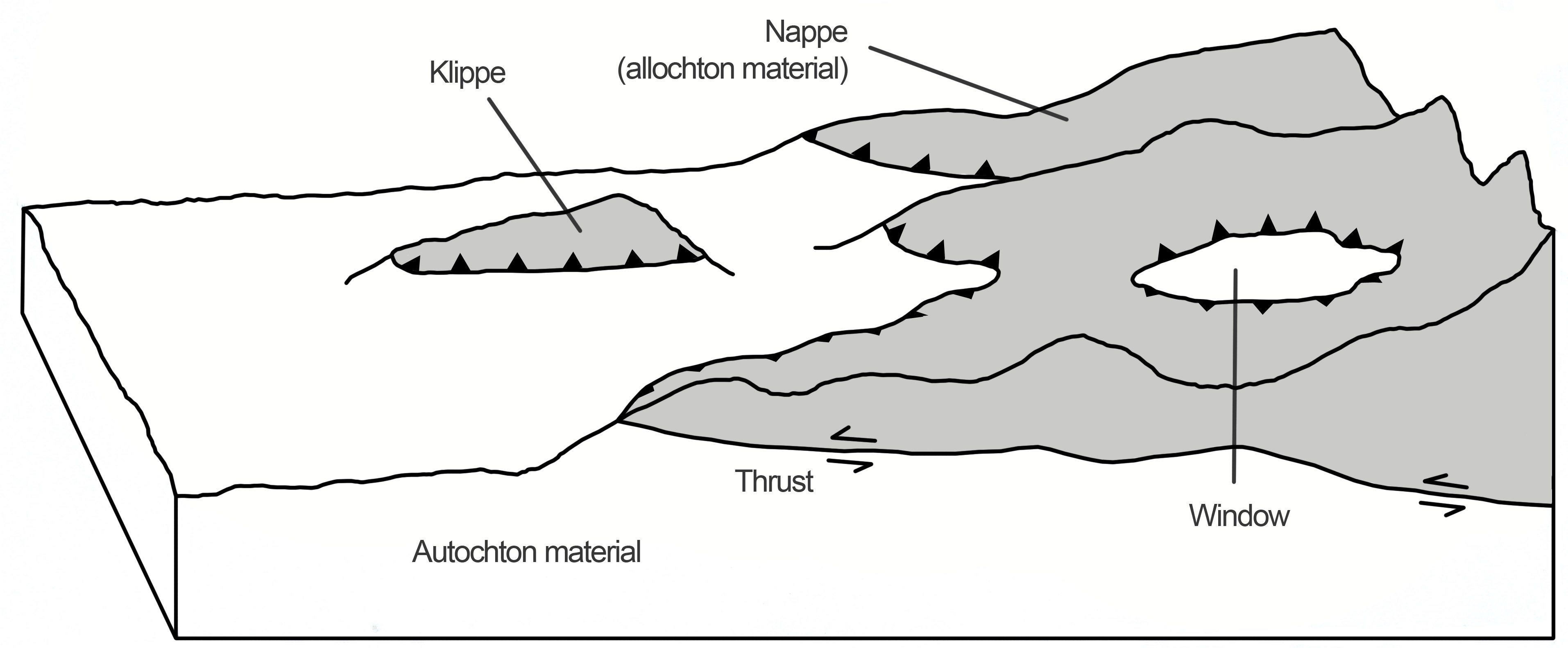
Duplex
form from the hinterland towards the foreland

Horses
convergent margins and thrust faults (notes)
Roof thrust
convergent margins and thrust faults (notes)
Sole thrust
convergent margins and thrust faults (notes)
decollement
convergent margins and thrust faults (notes)
back thrust
develop to accomidate strain when forethrusts cannot relieve stresses

frontal thrust vs lateral vs oblique
view image
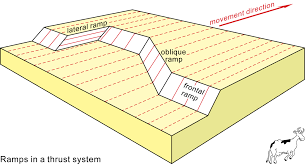
Hinterland
basement involved in deformation
foreland
deformation primarily in overlying sedimentary cover
thin vs thick skinned thrusts
thin is located above basement rock whereas thick skinned cuts across basement rock
detachment folds
folds as overlying units above a decollement fold. weak sedimentary layers that buckle
subduction zones formation
while unsure what initiates subduction. One plate sinks into the plate boundary due to density (cold) & old oceanic crust is denser than younger oceanic crust (warmer)
slab rollback
negative buoyancy of downgoing plate exerts a pulling force that causes the rest of the plate to sink (look at picture)
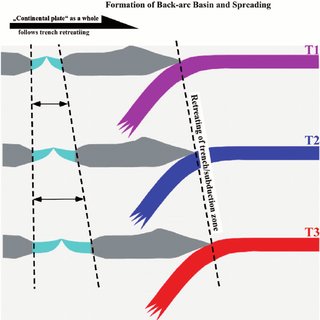
orogenic wedge
develops on thrust faults thicken the material brought to the subduction zone. Snow plow instance
accretionary prism
made of sediments from both planes
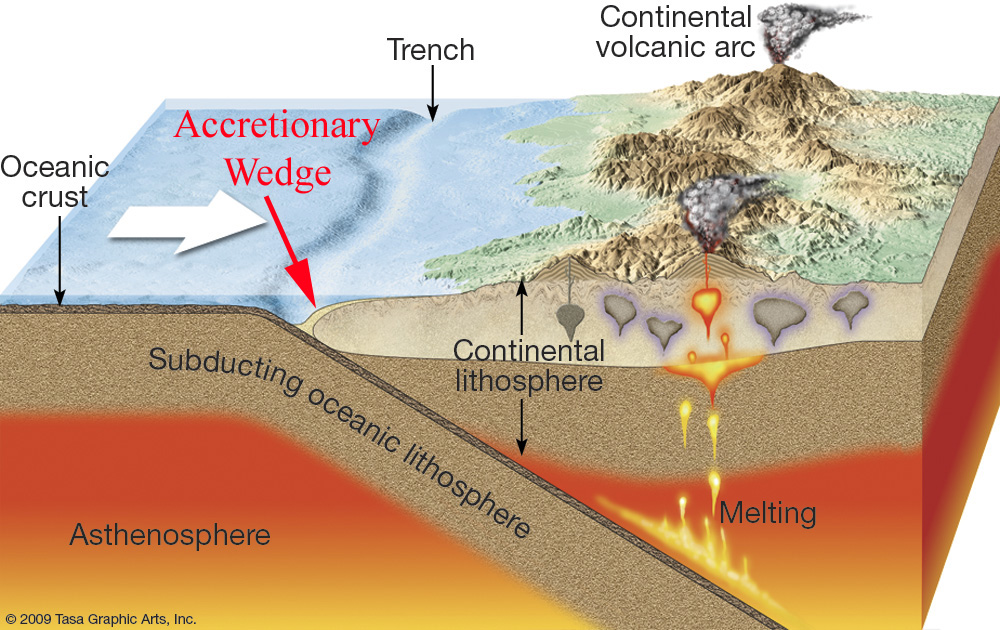
Critical taper angle
is related to the material properties of the wedge. friction at base and strength of material in wedge. The thicker the wedge, the faster the erosion.
load of wedge: row x g x H x sin(a+b)
load of water: row x g x D x sin(b)
Friction in wedges
high friction at base increases thickness of wedge
Overthickening in wedge
leads to collapse structures (slumps / normal faults)
orogenic collapse
as a bulldozer, it makes a thicker and thicker wedge and wedge becomes unstable and begins to collapse. If to thick, internal material starts to deform
Structure of the slab graph
convergent margins and thrust faults lecture
deep focus earthquakes
metamorphic reactions cause earthquakes. This includes volume change and water (water is released causing high fluid pressure, causing earthquakes). Shallow DFE, serpentine dehydration (breaks down). Deep DFE, olivine to wadsleyite to ringwoodite (aka changes in crystal structures). Structural transformation that makes the phases denser (change in volume)
Continental Arcs
one oceanic plate subducting beneath a continental plate
Island Arc
two oceanic plates one subducting beneath another
Continent-continent collision
one continental plate subducting beneath each other. Usually develops thick sedimentary deposits off of stable margins
Rift
belt of continental lithosphere that currently undergoing extension or has underwent extension. Extension of continental crust and is the 1st part of the wilson cycle. Normal faulting and flood basins occur.
terraine
chunck of continental crust from a continent that pulls apart
what causes rifitng
pulling apart of crust and a stretch of lithosphere.
Thermally activated rifts
develop in response to asthenospheric upwellings, chains of hot spots which makes the lithosphere stretch and thin
flexure related rifts
develop in response to beinding of plates. Form in downgoing slabs
graviational collapse rifitng
develop in response to extrusion of hot (soft) lower crustal rocks. Form in young orogenies
Back arc basin rifts
develop in response to slab pull cause by slab rollback. Subducting plate goes to fast causing suck which pulls on surrounding lithosphere.
Continental rifts
develop in response to slab pull and localize at or near old suture zones and is from subducting plates. Example- farrilon plate slides under continental plate and cooled causing pulling
pull apart rifts
in response to bends of faults (releasing bends)
Structures in rifts
normal faults, horsts, grabens, sometimes listric detachment faults. Folds can develop to accommodate for strain
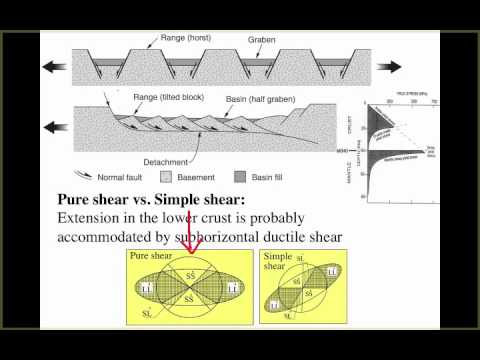
antithetic
opposite direction related to sense of shear
synthetic
same as the sense of shear on fault
modles of crustal rifting
pure shear, simple shear, delamination, and hybrid (mix of pure and simple shear) (look at rifitng lecture)
Basin and Range in US
formed by rollback of shallowly subducting farralon plate
evolution of rifting
two antithetic rift zones begin to interact with each other which form an accommodation zone. New fault zone forms that causes similar extensional deformation. Thinning of teh lithosphere causes upwelling and decompression melting of mantle. Upwelling evoles to form a new trough which becomes an oceanic spreading center
Pressure
sigma v (horizontal and vertical stresses) = pgh
differential stress
the difference between maximum and minimum principal stresses and is referred to as strength of material.
different environments related to stress (vertical)
Maximum compressive stress in extentional environments is vertical in image
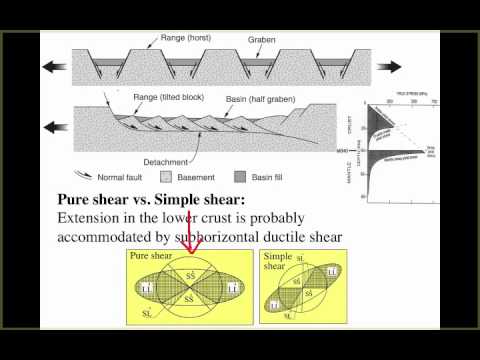
different environments related to stress (horizontal)
max compressive stress in compressive environments
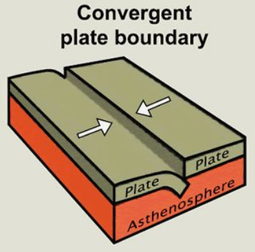
Pore Fluid Pressure
ratio of pore fluid pressure to vertical stress= Pp (pore fluid pressure) / sigma v (vertical stress)
Look at horizontal and vertical stresses mors circle
stress in crust lecture
Transfer faults
strike slip faults that transfer one kind of displacement to another. Two seperate faulting and it connects those two faults together. also called transform boundaries. Connect themselves from faulting
How do transfer faults and transform boundaries form
wing cracks (mode 1 cracks) connect extensional boundaries
San Andreas Fault
also known as a ridge-ridge boundary. connected by two spreading centers. One is from the farralon plate and goes to extensional boundary (spreading center)
transcurrent faults
strike slip faults that do not connect other boundaries. Oceanic crust coming in at an angle and moving the plate over, cause a strike slip.
oblique folding
view image
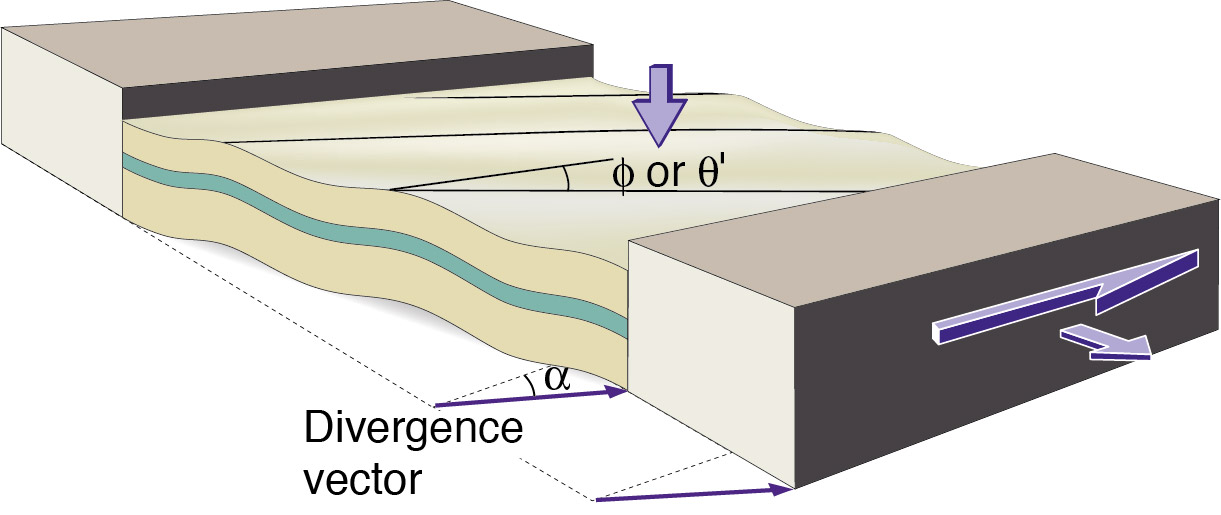
restraining-releasing
compressional structures in restraining belts and extensional structures in releasing bends
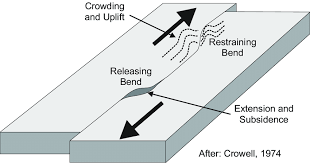
flower structures
series of normal or reverse faults observed in releasing or restraining bends. Negative in extension (goes down) and pos. in compression (goes up)
Rigid body strain
transltion and rotation and involve no internal deformation
Non rigid body strain
involves internal deformation of the body (distortion). Common in lower crust during ductile deformation
Homogenous strain
when original straight lines remain straight, parallel lines remain parallel, and circles become ellipses.
finite strain
the final state of deformation
incremental strains
are intermediate steps that lead to finite strain. may have different steps to lead to finite strains
noncoaxial
material lines do not remain principle strain axes (simple shear, top)
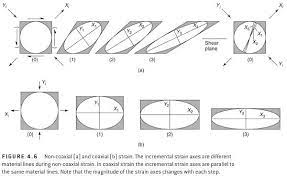
coaxial
material lines remain principle strain axes (pure shear, bottom)
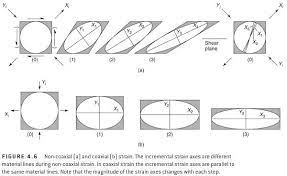
transpression
more vertical exaggeration (diagonal) Simple shear, y=tan (angular shear)
transtension
elongation of circle, pure shear, k= 1/kx
longitudinal strain
e= (Lo-L)/Lo
strain states
general strain
axially symmetric extension (hot dog)
axial symmetric shortening (hamberger)
Plane strain
Simple (uniaxial) shortening (no change in x and y but change in z)
Look at strain lecture
Flinn diagram
Look at strain lecture
Creep
1- primary creep (deceleration)
2- secondary creep aka steady state (constant rate of acceleration)
3- tertiary (accelerated)
Look at graph (stress and strain)
permanent strain
Look at graph (stress and strain)
linear reheologies
if ratio of stress/strain or sress/strain rate is constant
Elastic vs viscous
stress is applied but goes back to original shape. Viscous deforms under any pressure
viscoelastic
do not initially respond lineraly to the applied force but recover all strain after removal of applied force
elastico-viscous
materials are initially elastic then behave viscously and have recoverable portion of strain due to the elastic behavior